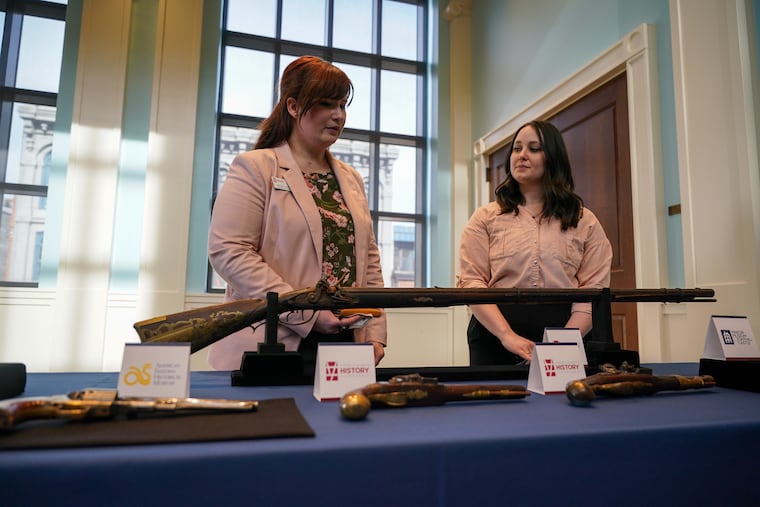Reunited with artifacts stolen almost 50 years ago, Pa. museum leaders say they’re better prepared against thieves
Six Pennsylvania museums were reunited with artifacts stolen from them almost 50 years ago. Museum leaders say security in the day made them easy targets but they've become better prepared.

Six Pennsylvania museums were reunited Friday with an assortment of firearms stolen by one man almost 50 years ago in heists that sometimes went unnoticed for years.
The repatriation of the artifacts highlights a transformation in museum security in decades since, making it much harder for thieves like Thomas Gavin to walk out with American treasures.
Gavin, the 78-year-old man behind the 1960s and ‘70s thefts, admitted to targeting dozens of museums up and down the East Coast when these institutions housing valuable artifacts were almost entirely volunteer-led.
The Hershey Museum and the Pennsylvania Farm Museum in Landis, Lancaster County, were among Gavin’s targets. His crimes went cold for so long that the statutes of limitations expired for many, which led Gavin to serve a mere one day in prison for trying to sell a historic rifle.
“Security, of course, was not what it is today,” said Scott Stephenson, president and CEO of the Museum of the American Revolution.
Gavin stole two English-made pocket pistols, a type that would be carried for personal defense in the 18th century, and French military pistols dating to the American Revolution from the museum’s predecessor, the Valley Forge Historical Society.
“Generally, there weren’t the sort of alarmed cases and that sort of thing, and so that made it a lot easier for a perpetrator to come in and steal objects,” explained Stephenson.
The few security provisions in place, such as the use of simple glass display cases that could be pried open with a crowbar, were easy for a thief like Gavin to overcome, according to federal investigators.
“He certainly did his homework, and each particular theft that we found was nuanced,” said FBI Special Agent Jake Archer.
Without giving too much about their security systems away, museum leaders say long gone are the days of being such easy targets. From limiting backpacks and puffy coats in rare collection rooms, to keeping cameras and staffers watching displays, museum leaders say they now take a layered approach to theft prevention.
Rachel Warner, director of collections at the York History Center, said the rifle and two horse pistols stolen from its predecessor, the Historical Society of York County, were easily set free from their cases in the 1970s.
Now, artifacts housed at the center are under literal lock and key, which require special tools to access. Other museums equip these cases with alarms.
And a theft would likely be noticed much faster today. Even smaller museums, such as the Mercer Museum of the Bucks County Historical Society, keep comprehensive records of their collections, as opposed to the occasional “spot checks” volunteers conducted in the past.
Cory Amsler, vice president of collections at the Mercer Museum, said complete audits have been the norm since the 1990s. He said it wasn’t until an audit of the museum’s collection in the 1990s that staff learned an 18th-century flintlock pistol had gone missing.
Gavin stole the pistol, though it’s unclear how. It was returned Friday.
“This is by no means the only item that you know is ‘missing’ in the museum’s holdings, unfortunately,” said Amsler.
While museum leaders feel confident about thwarting future thefts, they’re still left with logs of missing artifacts that could be anywhere.
Federal investigators and museum leaders hope repatriation ceremonies like the one Friday will raise awareness among antiques dealers and collectors.
“I hope that it will cause a snowball effect,” said Tracey Beck, executive director of the American Swedish Historical Museum.
After all, the museum was only reunited with a Civil War-era Colt revolver owned by an officer because an antiques dealer realized Gavin was attempting to sell him a different stolen artifact.
Antiques dealer Kelly Kinzle’s report would be the catalyst for the years-long process of returning Gavin’s pilfered historic firearms to their respective owners. Some had been resold to buyers as far as West Virginia and California.
The museum leaders who received artifacts said there were still dozens of items missing.
“People who are purchasing antiques or something, maybe will inquire a little bit about the provenance of an object and who the previous owners were and maybe further things will come out of the woodwork,” said Stephenson.